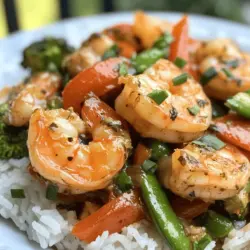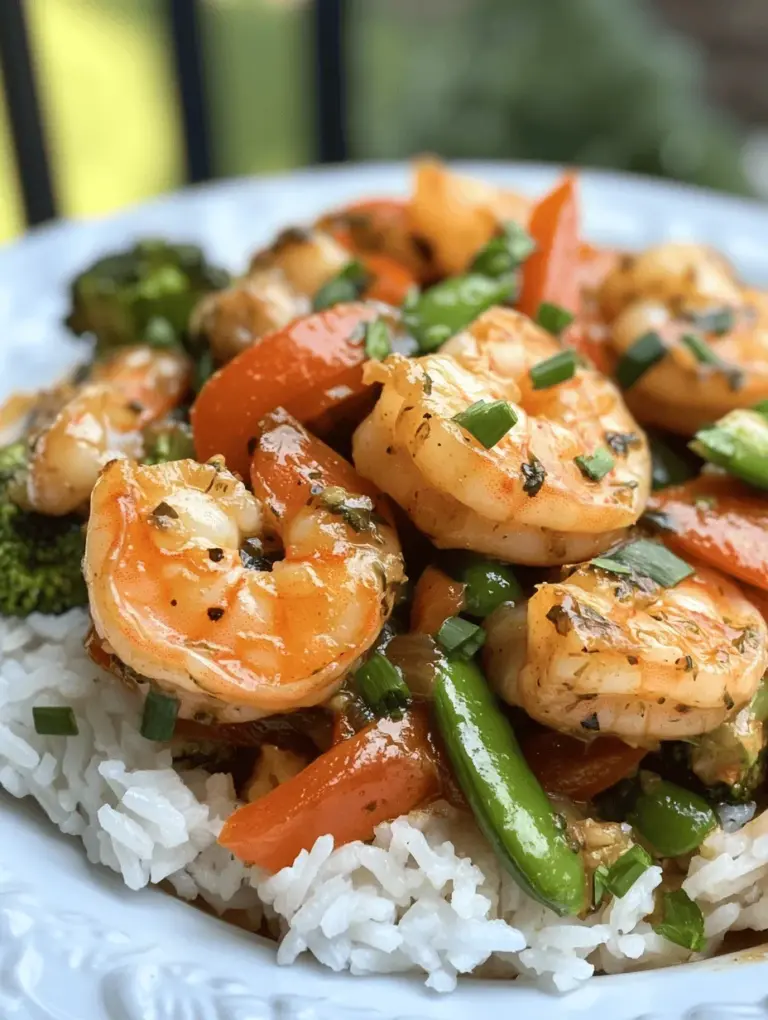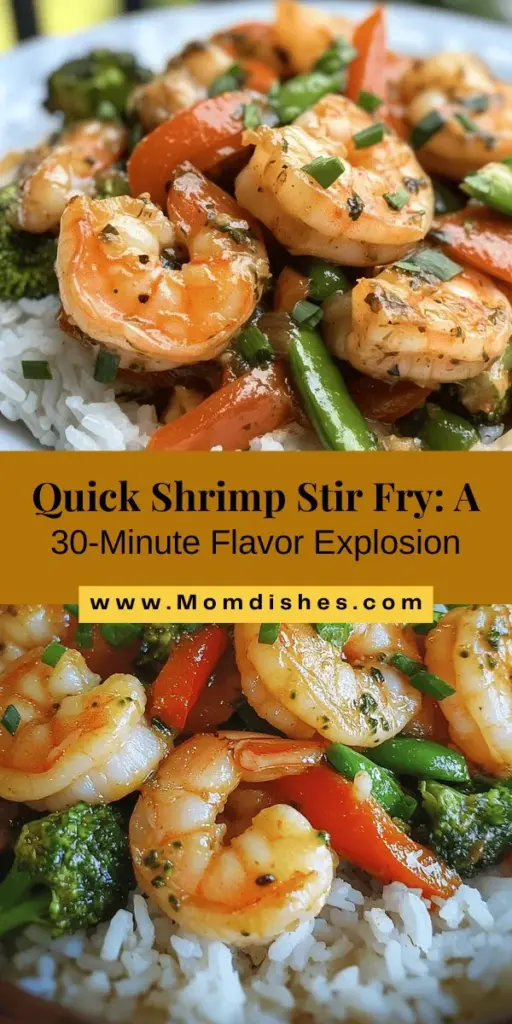Introduction
Stir fry dishes have long been a staple of Asian cuisine, revered for their vibrant flavors, quick cooking times, and versatility. Whether enjoyed in a bustling restaurant or whipped up in a home kitchen, stir fry recipes offer an exciting way to combine fresh ingredients and bold flavors in a single meal. Among these, the Quick and Easy Shrimp Stir Fry stands out as an exceptional choice—combining succulent shrimp with a medley of colorful vegetables and savory sauces to create a dish that is not only delicious but also healthy and time-efficient.
In today’s fast-paced world, the appeal of quick meals is undeniable. The Quick and Easy Shrimp Stir Fry caters to this need by providing a meal that can be prepared in under 30 minutes, making it an ideal option for busy weeknights. This dish brings together the goodness of fresh shrimp, various vegetables, and a flavorful sauce, resulting in a satisfying meal that leaves you feeling energized rather than weighed down.
The key to elevating the dining experience with this stir fry lies in the use of fresh ingredients and bold flavors. Fresh shrimp, crisp vegetables, and aromatic seasonings come together to create a symphony of tastes that will tantalize your taste buds. As we delve into the details of this recipe, you’ll discover how to harness the vibrant flavors and nutritional benefits of each ingredient, ensuring that your Quick and Easy Shrimp Stir Fry is not only a delight to eat but also a nourishing choice.
Understanding Shrimp as a Protein Source
Shrimp is not just a delicious seafood option; it also boasts an impressive nutritional profile. As a lean protein, shrimp is low in calories while being high in protein, making it an excellent choice for those looking to maintain a healthy diet. A typical serving of shrimp contains about 20 grams of protein, with only around 100 calories, which makes it a fantastic option for anyone seeking to build muscle or manage their weight.
In addition to being an excellent source of protein, shrimp is rich in essential nutrients. It contains significant amounts of selenium, a powerful antioxidant that plays a crucial role in metabolism and thyroid function. Furthermore, shrimp is an excellent source of vitamin B12, important for red blood cell formation and neurological function. Incorporating shrimp into your meals can contribute to your overall nutritional needs while adding delightful flavor and texture.
As consumers become increasingly aware of sustainability, it is essential to consider how and where shrimp is sourced. Overfishing and harmful farming practices can significantly impact marine ecosystems, so opting for responsibly sourced shrimp is vital. Look for labels indicating that shrimp is wild-caught or certified by reputable organizations that ensure sustainable practices. By making informed choices at the market or grocery store, you can enjoy your shrimp dishes while supporting the environment.
When selecting shrimp, freshness is paramount. Fresh shrimp should have a mild, briny scent and a firm texture. Avoid shrimp that has a strong, fishy odor or appears slimy. If you are purchasing frozen shrimp, ensure it is properly sealed and look for frozen shrimp that is flash-frozen shortly after being caught to preserve freshness. Whether you choose fresh or frozen, knowing how to properly select shrimp will elevate your stir fry to new heights.
Essential Ingredients for Quick and Easy Shrimp Stir Fry
Creating a mouthwatering Quick and Easy Shrimp Stir Fry begins with the right ingredients. Here’s a detailed overview of each essential component that contributes to this dish’s delightful flavors and textures.
Large Shrimp
The star of the dish, large shrimp, should be the focal point of your stir fry. Typically labeled as “jumbo” or “extra-large,” these shrimp provide a satisfying bite and a succulent texture. Before cooking, it is essential to rinse the shrimp under cold water and pat them dry with paper towels. This step not only removes any excess moisture but also helps the shrimp sear beautifully in the hot pan. For added flavor, consider marinating the shrimp briefly in a mixture of soy sauce, garlic, and ginger before cooking.
Vegetable Oil
When it comes to stir frying, the choice of oil can significantly impact the final dish. Opt for high smoke point oils, such as canola oil, peanut oil, or grapeseed oil, which can withstand the high temperatures required for stir frying without burning. The right oil enhances the flavors of the dish while ensuring that the ingredients cook evenly. A neutral oil allows the natural flavors of the shrimp and vegetables to shine through, making it the ideal choice for this recipe.
Garlic and Ginger
No stir fry would be complete without the aromatic duo of garlic and ginger. These two ingredients not only add depth of flavor but also come with numerous health benefits. Garlic is known for its immune-boosting properties, while ginger is celebrated for its anti-inflammatory effects and digestive support. Minced or finely chopped, both garlic and ginger should be sautéed briefly in the hot oil before adding the shrimp, allowing their flavors to infuse the dish.
Vegetables
A colorful array of vegetables is crucial for a well-rounded stir fry, both in terms of flavor and nutrition. In this recipe, we recommend red bell pepper, snap peas, and broccoli.
– Red Bell Pepper: Sweet and crunchy, red bell peppers are rich in vitamins A and C, making them a fantastic addition to your stir fry. They add a pop of color and a hint of sweetness that balances the savory elements of the dish.
– Snap Peas: These tender, crisp peas are a great source of fiber and vitamins A and C. Their natural sweetness and satisfying crunch make them a perfect complement to the shrimp.
– Broccoli: Packed with vitamins K and C, broccoli is a nutrient powerhouse that adds both texture and flavor to the stir fry. Its slight earthiness pairs wonderfully with the other ingredients, enhancing the overall taste profile.
Sauces
The right sauces take your stir fry from good to unforgettable. For this recipe, we recommend a combination of soy sauce, oyster sauce, and sesame oil.
– Soy Sauce: A staple in Asian cuisine, soy sauce adds umami and saltiness to the dish. Opt for low-sodium soy sauce if you want to control the salt content while still enjoying rich flavor.
– Oyster Sauce: This thick, savory sauce is made from oyster extracts and adds depth and complexity to your stir fry. It’s a fantastic way to enhance the natural sweetness of the vegetables and the shrimp.
– Sesame Oil: With its nutty flavor, sesame oil should be used sparingly as a finishing touch to add aroma and richness. A drizzle of sesame oil just before serving elevates the dish and ties all the flavors together.
Optional Serving Suggestions
While the Quick and Easy Shrimp Stir Fry can be enjoyed on its own, serving it over a bed of rice or noodles can make it even more satisfying. Steamed jasmine rice, brown rice, or even quinoa can serve as a nutritious base for the stir fry. If you prefer noodles, consider using rice noodles, soba noodles, or even whole wheat spaghetti for an alternative twist. These options not only enhance the meal’s presentation but also provide additional carbohydrates for energy.
By carefully selecting fresh ingredients and understanding their roles in the recipe, you can create a Quick and Easy Shrimp Stir Fry that is not only delicious but also packed with nutrients and flavor. Now that you’re familiar with the essential components, let’s dive into the step-by-step instructions for preparing this delightful dish.
Step-by-Step Instructions for Making Quick and Easy Shrimp Stir Fry
Preparing the Shrimp
The first step in crafting your Quick and Easy Shrimp Stir Fry is to prepare the shrimp properly. Rinse them under cold water to cleanse any impurities, then pat them dry using paper towels. Removing excess moisture is crucial for achieving a perfect sear. After drying, consider seasoning the shrimp lightly with salt and pepper or marinating them in a simple mixture of soy sauce, garlic, and ginger for about 10-15 minutes. This quick marinade infuses the shrimp with flavor and enhances their natural taste.
Heating and Using Oil
Next, it’s time to heat the vegetable oil in your wok or a large skillet. For optimal results, choose a high smoke point oil, such as canola or peanut oil, as mentioned earlier. Place the pan over medium-high heat and allow it to preheat for a minute or two.
To test if the oil is ready, sprinkle a few drops of water into the pan; if they sizzle and evaporate immediately, the oil is at the right temperature for cooking. When the oil is hot, carefully add the shrimp in a single layer, ensuring they are not overcrowded. This allows for even cooking and a nice sear, which is essential for flavor development.
Sautéing Aromatics
After adding the shrimp to the hot oil, let them cook undisturbed for about 2-3 minutes until they turn pink and opaque. Once the shrimp are nearly cooked through, it’s time to add the minced garlic and ginger. Adding these aromatics at this stage allows their flavors to bloom and permeate the shrimp. Stir-fry everything together for an additional minute, ensuring the garlic and ginger do not burn, as they can turn bitter if overcooked.
As the aroma fills your kitchen, the vibrant colors of the vegetables will soon follow, making this Quick and Easy Shrimp Stir Fry an enticing dish that is as visually appealing as it is delicious.
Stay tuned for the next part of the article, where we’ll explore how to finish the stir fry with vegetables and sauces, along with expert tips for achieving the perfect balance of flavors in your dish.
{{image_1}}
Techniques for Achieving the Perfect Balance of Flavors Without Burning
When it comes to stir-frying, balancing flavors while preventing burning is key to achieving a delicious dish. Begin by ensuring your wok or pan is preheated to a high temperature before adding any ingredients. The heat should be sufficient enough to sear the shrimp and vegetables quickly, creating a beautiful caramelization that enhances flavor without cooking them into oblivion.
Use oils with a high smoke point, such as canola or peanut oil, to prevent burning. This allows you to achieve that coveted stir-fried taste without risking bitterness from burnt ingredients. When adding sauces, do so gradually and avoid overcrowding the pan, which can lower the temperature and create steam rather than sear.
Cooking the Shrimp
Shrimp cooks quickly, so timing is essential to avoid overcooking. Begin by tossing the shrimp into the hot pan and spreading them out evenly. As they cook, watch for visual cues: shrimp will turn from gray to a bright pink and will begin to curl slightly. This usually takes about 2-3 minutes on each side depending on their size.
To achieve the perfect texture, refrain from stirring too often. Allow the shrimp to sear on one side before flipping them. This promotes a delicious crust while keeping the inside juicy. Remove the shrimp from the pan as soon as they are opaque and firm to the touch; they will continue to cook slightly after being removed from heat.
Stir-Frying Vegetables
Cooking vegetables properly is crucial in a stir-fry to maintain their nutritional value and texture. Aim for a mix of vegetables that includes both crunchy and tender varieties, such as bell peppers, broccoli, and snap peas.
To maximize flavor and texture, add firmer vegetables that require longer cooking times first, such as carrots or broccoli stems. After a minute or two, add softer vegetables like bell peppers and snap peas. This staggered approach ensures that everything reaches the ideal tenderness without becoming mushy. Stir-fry the vegetables for 3-5 minutes, or until they are vibrant and tender-crisp.
Combining Ingredients
Integrating sauces into your stir-fry is where the magic happens. After your shrimp and vegetables are cooked, push them to one side of the pan and pour your sauce into the empty space. This allows the sauce to heat up and thicken slightly before being mixed in. Stir gently, ensuring every piece is evenly coated with sauce. This technique not only enhances flavor but also ensures that the shrimp and veggies retain their individual tastes.
For final cooking tips, consider adding a splash of water or broth to the pan to create a bit of steam, which helps meld the flavors together. Stir-fry for an additional minute to allow the ingredients to absorb the sauce thoroughly.
Presentation and Serving
Presentation matters when serving your Quick and Easy Shrimp Stir Fry. To garnish, finely chop green onions and sprinkle them over the dish for a pop of color and fresh flavor.
For an appealing presentation, consider plating the stir-fry over a bed of rice or quinoa. This not only elevates the appearance but also adds a complementary texture. Arrange the shrimp and vegetables artfully, allowing the vibrant colors to shine through.
Tips for Customizing Your Shrimp Stir Fry
One of the best aspects of stir-frying is its versatility. Feel free to explore various vegetables based on seasonal availability. Asparagus in spring, zucchini in summer, and root vegetables in fall can all bring unique flavors and textures to your dish.
If shrimp isn’t your protein of choice, consider substituting it with chicken, beef, or tofu. Just be mindful of adjusting cooking times accordingly. Chicken may take a few minutes longer to cook, whereas tofu, if pre-cooked or pressed, will require less time.
For those who enjoy a bit more heat, think about incorporating chili paste or fresh sliced chili peppers into your stir-fry. A squeeze of lime juice just before serving can also add a refreshing zest that brightens the overall flavor.
Health Benefits of Cooking with Fresh Ingredients
Using fresh produce is paramount in any healthy diet. Fresh vegetables and proteins retain their nutritional value significantly better than processed ingredients often found in takeout meals. Shrimp, for instance, is an excellent source of lean protein and essential minerals, while colorful vegetables are packed with vitamins and antioxidants.
Homemade meals allow for better control over ingredients, making it easier to avoid excess sodium, sugars, and unhealthy fats. Plus, cooking at home encourages mindful eating, allowing you to appreciate the flavors and textures of whole foods. It’s not just about the meal; it’s about the experience of cooking and sharing it with loved ones.
Conclusion
The Quick and Easy Shrimp Stir Fry is a nutritious, versatile, and straightforward recipe that can easily become a staple in your kitchen. With a few simple techniques, you can create a dish that bursts with flavor and color, perfect for any occasion.
Don’t hesitate to experiment with different ingredients, flavors, and heat levels to make this dish your own. Remember, the joy of cooking lies in the ability to be creative and share delicious meals with those you love. So gather your ingredients, fire up that wok, and enjoy the delightful journey of preparing your own flavorful stir-fry!


